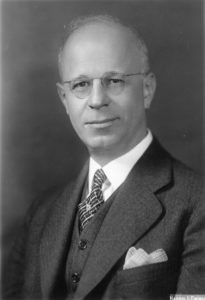JULIAN MORGENSTERN (1881-1976)
After his ordination at HUC in 1902, Julian Morgenstern studied in Europe and received his doctorate from the University of Heidelberg. He served several small congregations in the Midwest, and then returned to HUC in 1907, the first American-born scholar to be appointed to the HUC faculty.
On January 29, 1921, a minority of the Board of Governors recommended Julian Morgenstern, a member of the HUC faculty, to serve as “acting president.” The Board later chose Morgenstern as permanent president. Morgenstern, as a member of the HUC faculty, was a strong choice for interim president. After doing everything in his power to prove his capabilities as College president (which included campaigning for the College in major Jewish communities across the country, raising money, recruiting students, appointing new faculty members, and revising the curriculum), Morgenstern was elected to a two-year term by the Board of Governors (starting Fall 1922). He ended up leading the College until 1947. Morgenstern was the first American-born President of HUC and the first HUC alumnus to lead the school.
During Morgenstern’s presidency, HUC grew dramatically. He established the departments of social studies, education, and music, and launched the Hebrew Union College Press and the Hebrew Union College Annual (both of which remain in existence).
A courageous and far-sighted leader, Morgenstern’s greatest accomplishment may well have been his work on behalf of the “refugee scholars project” which brought scholars and students from Germany to Cincinnati prior to the U.S. entry into World War II. In Fall 1935, under the leadership of Julian Morgenstern, the College arranged for five students from a liberal German seminary to come to the United States and pursue studies at the College. In the following years, three more students from Europe arrived under this same fellowship. The Board agreed to fully underwrite the expenses for all of these students. By 1938, refugee students made up 12% of the HUC student body; still, many were turned away.
The College also employed refugee professors who made their way to the U.S. through other means. Among these refugee scholars is the now renowned Abraham Joshua Heschel. Abraham Joshua Heschel (b. 1907 d. 1972) – one of the renowned rescued scholars – referred to Morgenstern as “the least appreciated man in American Jewry.” Most of the refugees that Morgenstern helped during those dark years went on to enrich the American Jewish community.
The faculty scholars included: Max Weiner, Franz Rosenthal, Eugen Taubler (Bible and Hellenistic literature), Isaiah Sonne (medieval Jewish History), Franz Landsberger (Jewish art), Abraham Joshua Heschel, Julius Lewry, Alexander Guttman, Eric Werner, and Samuel Atlas.
On June 18, 1938, Jacob R. Marcus wrote to Julian Morgenstern regarding the refugee scholars project:
“It is ironical that the Reform (assimilationist!!) seminary takes in the European semi-orthodox but other institutions in this country won’t give them a break!! We have no alternative morally, but we are certainly complicating our rabbinical problems with these men.” (AJA Box 1560)
Under Morgenstern’s leadership at the College, “students enjoyed complete freedom of expression. They were at liberty to be Zionists or anti-Zionists, theists or humanists, conservatives or socialist, pacifists or non-pacifists. They could and did invite controversial agnostic lawyer Clarence Darrow to speak to them in 1930…Student sermons were no longer censored; in the pages of the HUC Monthly students could openly criticize the college without provoking any disciplinary action” (Meyer, 104).
Furthermore, Morgenstern oversaw the beginnings of the merger between the Hebrew Union College and the Jewish Institute of Religion. However, in Fall 1946, Morgenstern read his letter of retirement to the HUC Board of Governors, set to take effect at the end of the academic year.
“Not insignificant in Morgenstern’s decision must also have been the realization that a very exciting prospect now loomed on the horizon: a merger with Stephen Wise’s Jewish Institute of Religion in New York. Yet only under a younger man, acceptable to the Zionist supporters of the JIR, could the separate histories of the two institutions flow into a common stream” (Meyer, 136)
Julian Morgenstern died in December 1976.
Meyer, Michael A. Hebrew Union College-Jewish Institute of Religion: A Centennial History 1875-1975. Hebrew Union College Press, 1992


